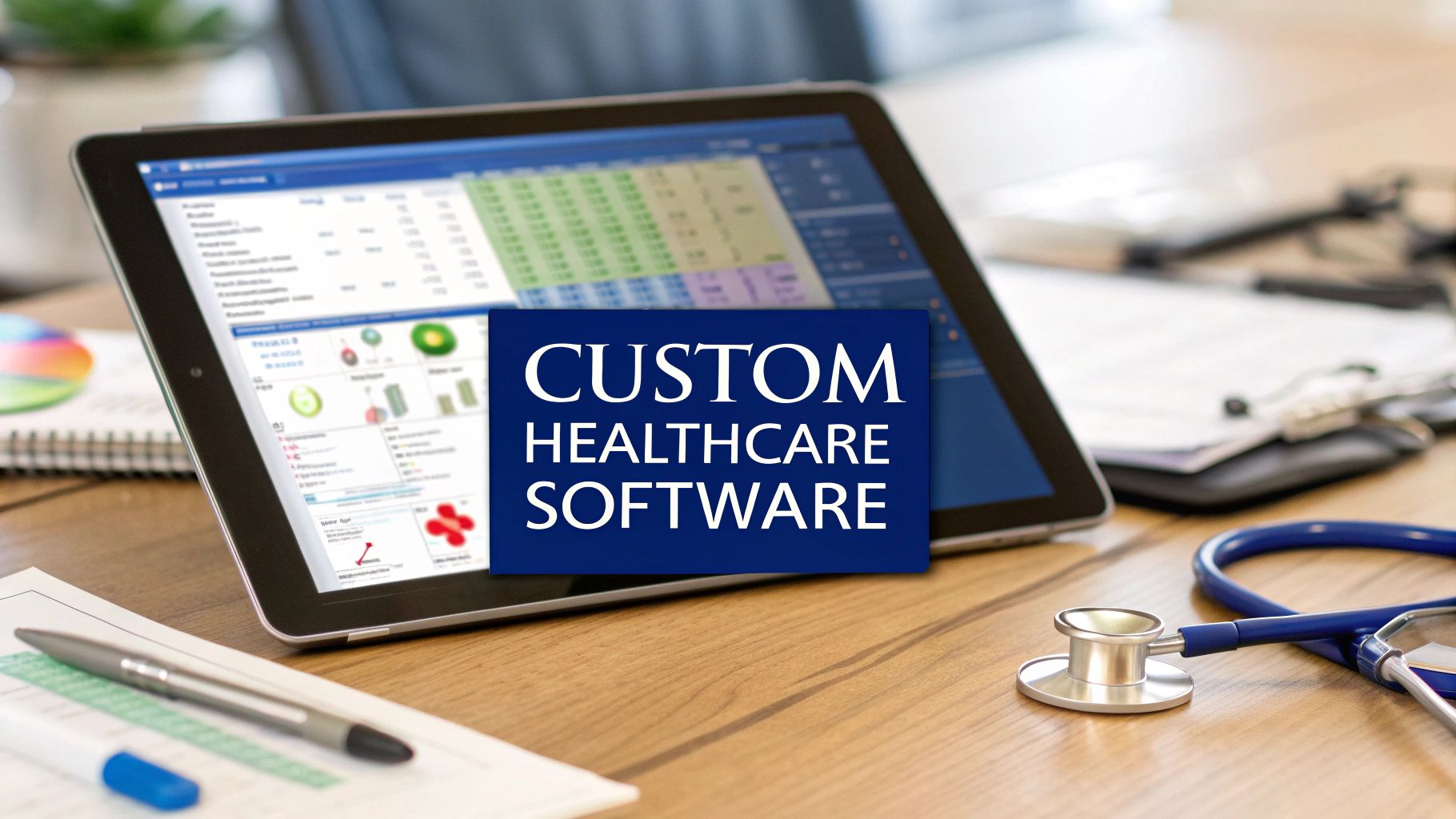AI healthcare solutions in Canada are increasingly being adopted to address systemic challenges like administrative burdens and workforce shortages.
The AI Revolution in Canadian Healthcare

Let's be honest: Canada's healthcare system is under immense pressure. Administrative overload, persistent staff shortages, and frustratingly long wait times are straining it to a breaking point. This is the very environment where artificial intelligence is starting to make a real difference, not by replacing our invaluable clinicians, but by acting as a powerful new tool in their kits.
Think of AI as an incredibly capable assistant. It can sift through mountains of data in moments and handle repetitive tasks with a level of speed and accuracy that's simply not humanly possible.
This shift is crucial. It frees up doctors, nurses, and specialists to focus on what they do best: caring for patients. By taking on the mundane but necessary work, AI helps reduce burnout and makes the entire operational flow of a hospital or clinic smoother. Ultimately, the goal is to build a more resilient and efficient healthcare system for every Canadian.
Addressing Key System Challenges
The daily grind for a Canadian healthcare professional is intense. A huge portion of their time gets eaten up by administrative work and chasing down incomplete patient records, which directly chips away at the quality and speed of care.
The Philips Future Health Index 2025 report paints a stark picture. A staggering 85% of Canadian healthcare professionals say they lose precious clinical time because patient data is hard to access. Nearly half of them lose more than 45 minutes every single shift. That's a massive bottleneck, especially when you consider that one in five Canadians reported they ended up in the hospital while on a waiting list for care.
The same report found that 90% of Canadian HCPs are convinced that well-implemented AI could win back that lost time. The urgency for intelligent automation couldn't be clearer. You can dig into the complete findings to learn more about AI's potential in Canadian healthcare.
The core promise of AI here is quite simple: to augment human expertise so we can achieve better outcomes. It automates tedious work and delivers data-driven insights, empowering clinicians to work at the top of their licence.
Practical Applications Transforming Care
This guide is designed to walk you through the real-world applications that are part of the AI healthcare solutions Canada is starting to embrace. We'll look at everything from smarter diagnostics that can spot diseases earlier to streamlined administrative workflows that cut down on paperwork and operational headaches.
AI is also becoming a part of our daily lives through consumer devices that offer sophisticated health monitoring. Tools like those described in this overview of Apple Watch health features are pushing us toward a future of more proactive and personalised health management.
Our journey will cover a few key areas:
-
Smarter Diagnostics: How machine learning algorithms are giving radiologists and pathologists a second set of eyes to detect conditions with higher precision.
-
Workflow Automation: The impact of AI on tedious tasks like scheduling, billing, and patient communication, freeing up skilled administrative staff.
-
Personalised Treatment: Using AI to analyse unique patient data to help clinicians develop tailored care plans that get better results.
-
Patient Engagement: Creating tools that empower patients to become active participants in managing their own health.
We’ll also dive into the unique Canadian regulatory landscape, lay out a clear roadmap for implementation, and tackle the critical ethical questions head-on. It’s a complete picture for any healthcare leader ready to move forward.
Getting a Handle on Canada's AI Healthcare Market
It's impossible to ignore the shift happening in Canadian healthcare. A powerful current of investment and innovation is reshaping how we think about delivering care, and artificial intelligence is at the very heart of this change. The market for AI healthcare solutions in Canada isn't just growing; it's exploding, signalling a fundamental rewiring of our entire system.
This isn't just a trend. Think of it as a necessary evolution. We're seeing AI being put to work to solve some of the most stubborn, long-standing challenges our healthcare system faces, from diagnostic bottlenecks to operational inefficiencies.
The Sheer Scale of the Opportunity
The numbers tell a story of incredible momentum. In 2023, Canada’s AI in healthcare market was already valued at a significant USD 1.13 billion. But the real story is where it's headed. Projections show it rocketing to an estimated USD 10.77 billion by 2030. That’s a compound annual growth rate (CAGR) of 37.9%. This isn't just abstract growth; it's fuelled by real breakthroughs in medical imaging, cancer research, and patient-specific treatments. You can find more insights on AI in healthcare statistics to see the global picture.
This financial energy is translating directly into innovation on the ground. We’re witnessing pioneering collaborations between world-class Canadian hospitals and leading tech firms. These aren't just pilot projects anymore; they're delivering tangible, measurable results for patients today.
What’s Fuelling This Growth?
Several key areas are acting as catalysts for this expansion. Each one targets a critical pressure point within the Canadian healthcare system, promising to make things more efficient, more accurate, and more personal.
-
AI-Powered Medical Imaging: We're seeing algorithms trained to review X-rays, CTs, and MRIs with remarkable precision. This technology acts as a second set of expert eyes for radiologists, helping to spot signs of disease earlier and with greater accuracy.
-
Personalised Medicine and Genomics: AI is now capable of sifting through a patient's genetic data to predict their risk for specific conditions. This allows clinicians to move beyond one-size-fits-all treatments and design care plans that are tailored to an individual’s unique biological makeup.
-
Optimising Hospital Operations: It’s not all about the clinical side. AI is also working behind the scenes to streamline the complex logistics of running a hospital. This includes everything from automating patient scheduling and predicting emergency room volumes to managing medical supply chains more effectively.
The core idea here is simple: apply AI where it can make the biggest, most immediate difference. It’s about making diagnostics faster, treatments more personal, and hospital operations smarter.
Canadian Success Stories in Action
The adoption of AI healthcare solutions in Canada is already making a real impact. For example, Toronto's Humber River Hospital has teamed up with GE HealthCare to use AI tools that analyse clinical data in real-time, significantly boosting their diagnostic capabilities.
In another powerful example, Microsoft Canada is working with BC Cancer to use the Azure cloud to analyse tumour data right down to the cellular level. This research is helping clinicians predict how patients will respond to chemotherapy, opening the door to far more effective cancer treatments. These aren't futuristic concepts; they are practical applications improving care right now. For a closer look at these innovations, you might be interested in our guide on AI solutions for hospitals in Canada.
And this is really just the beginning. As the technology matures and data becomes more integrated, we can expect to see even more groundbreaking applications emerge from coast to coast. The path forward is clear: a more connected, data-driven, and intelligent healthcare future for all Canadians.
To better understand where AI is making its mark, this table breaks down the most common applications we're seeing across the country.
Key Applications of AI in Canadian Healthcare
| AI Application Area | Specific Function | Primary Benefit |
|---|---|---|
| Medical Diagnostics | Analysing medical images (X-rays, MRIs, CT scans) to detect anomalies like tumours or fractures. | Improved accuracy, earlier disease detection, and reduced workload for radiologists. |
| Predictive Analytics | Forecasting patient admissions, disease outbreaks, or an individual's risk of developing a chronic condition. | Proactive resource allocation, better public health responses, and preventive patient care. |
| Workflow Automation | Automating administrative tasks like patient scheduling, billing, and medical record updates. | Reduced administrative burden on clinical staff, fewer errors, and improved operational efficiency. |
| Personalised Treatment | Analysing genomic and clinical data to recommend tailored drug therapies or treatment plans. | Higher treatment efficacy, fewer adverse side effects, and better patient outcomes. |
| Patient Triage & Engagement | Using AI-powered chatbots to answer patient queries, assess symptoms, and direct them to appropriate care. | 24/7 patient support, reduced wait times for non-urgent care, and improved patient experience. |
These examples show the breadth of AI's potential. From the front lines of patient care to the back-office systems that keep hospitals running, intelligent technology is becoming an indispensable part of modern healthcare delivery in Canada.
Navigating Canadian Regulations and Data Privacy
Putting AI to work in healthcare isn't just a technical challenge; it’s a deep dive into Canada's intricate web of regulations. To successfully launch any AI healthcare solution in Canada, you absolutely must have a rock-solid understanding of the laws protecting patient data. Getting this wrong isn't just a misstep; it can trigger serious legal trouble and shatter the trust you have with patients.
This isn’t about looking for loopholes. It’s about building compliance right into the foundation of your project, making sure every single piece of data is handled with the security and respect it deserves. For any leader in the healthcare space, getting a handle on this landscape is non-negotiable.
The Federal and Provincial Privacy Puzzle
Canada's privacy framework is a two-layered cake. Federal laws set the baseline, but provincial legislation often adds thicker, stricter layers of rules specifically for healthcare. Think of it like a national building code that ensures a basic level of safety, but each province can demand stronger foundations or extra fireproofing.
The main federal law is the Personal Information Protection and Electronic Documents Act (PIPEDA). It sets the ground rules for how private-sector organisations can collect, use, and share personal information in their commercial activities. This is where the core principles of consent, security, and accountability come from.
But since healthcare is managed provincially, the local laws are often the ones you really need to watch.
-
Ontario's PHIPA: The Personal Health Information Protection Act gets very specific about how patient data is managed by healthcare "custodians" in the province.
-
Quebec's Bill 64: Now known as Law 25, this act brings in some of North America's toughest privacy rules, complete with hefty fines for getting it wrong.
-
Alberta's HIA: The Health Information Act works similarly, creating a clear framework for how health information is handled within Alberta's system.
Juggling these overlapping laws can be a real headache. For a closer look, our guide on AI in healthcare data privacy in Canada digs much deeper into what these critical regulations mean in practice.
When AI Becomes a Medical Device
Here’s where things get interesting. If your AI tool is used for a medical purpose, like helping to diagnose a condition or suggesting a treatment, Health Canada may see it as Software as a Medical Device (SaMD). This label is a huge deal because it dictates how much regulatory oversight the tool will face.
Think of it like getting a driver's licence. An AI tool that just helps with administrative scheduling is like getting your standard car licence – it needs to pass some basic tests, but isn't considered high-risk.
On the other hand, a sophisticated AI that scans medical images to spot signs of cancer is more like getting a commercial pilot's licence. It has to go through rigorous, evidence-based validation to prove it's safe and effective before it can ever be used with patients.
Health Canada uses a risk-based system from Class I (lowest risk) to Class IV (highest risk). An AI diagnostic tool would almost certainly land in a higher-risk category, which means you'll need to provide extensive clinical evidence and have a top-notch quality management system to get it approved.
The Pillars of Compliant AI Deployment
Beyond the letter of the law, a successful and ethical AI project is built on a few fundamental principles. These are the practical pillars that hold up patient trust and ensure your solution is both responsible and legally sound.
-
Transparent Data Governance: You need crystal-clear policies that spell out what data you're collecting, exactly why the AI model needs it, and who gets to see it. This isn’t just a box to tick; it’s a public commitment to transparency that builds real confidence with clinicians and patients alike.
-
Informed Patient Consent: Consent can't be buried in the fine print. It has to be explicit, informed, and specific to the task. Patients must understand precisely how their data will be used to train or run an AI system, and they need the freedom to opt out without it impacting their care.
-
Robust Cybersecurity Measures: Protecting sensitive health data from a breach is absolutely critical. This means deploying strong encryption, tight access controls, and conducting regular security audits to shield that information from anyone who shouldn't see it.
-
Rigorous Model Validation: Before you even think about going live, your AI models have to be thoroughly tested for accuracy, fairness, and bias. This means using diverse, representative datasets to see how they perform in the real world. And this isn't a one-and-done check; validation is an ongoing process to make sure the model stays reliable as new data flows in.
Your Roadmap for Implementing Healthcare AI
Jumping into an AI project isn't just about buying new tech; it’s about having a smart, practical plan. For any Canadian healthcare organisation, this means taking a step-by-step approach, from a simple idea to a fully integrated solution that actually makes a difference. A solid roadmap is what separates a stalled, frustrating project from one that genuinely improves patient care and makes daily operations smoother.
The first move has nothing to do with algorithms or vendors. It’s about getting crystal clear on the problem you’re trying to solve. Don’t lead with the technology; lead with the pain point. Are your clinicians buried in paperwork? Are diagnostic bottlenecks causing treatment delays? Start there.
Identifying and Prioritising Your Pilot Project
Once you’ve zeroed in on a real problem, it’s time to choose a pilot project. A good pilot is small, manageable, and has the potential to deliver a big win. Think of it as a controlled experiment – a chance to prove that AI can work in your specific environment before you go all-in.
Your pilot needs to tackle a well-defined challenge where you can clearly measure success. For example, instead of a vague goal like "improve diagnostics," a much better pilot would be to "reduce the turnaround time for preliminary chest X-ray analysis by 25%." That kind of specific target makes it much easier to build a compelling business case and show stakeholders a clear return on their investment.
This is also when you start putting together your internal A-team. You'll need a mix of people: clinical champions who live and breathe the workflow, IT experts who can handle the technical side, and leaders who can navigate the organisational red tape. For a great breakdown on this, check out this guide on hiring AI talent in non-tech industries like healthcare.
This visual flow shows the regulatory journey an AI solution must take in Canada, from federal privacy laws to provincial health rules and specific medical device classifications.

The infographic really drives home that compliance isn't a single checkbox. It’s a multi-layered process that demands expertise at the federal, provincial, and device-specific levels to make sure a solution is both legal and safe.
Choosing the Right Partner
Picking the right technology partner is easily one of the most important decisions you'll make. This isn't just about finding a software provider. You need a strategic partner who genuinely understands the tangled web of the Canadian healthcare system, especially our strict privacy and regulatory rules.
When you’re vetting vendors, look past the shiny technical features of their AI healthcare solutions. A real partner will have a proven track record of navigating PIPEDA, provincial laws like Ontario's PHIPA, and the Health Canada SaMD classification process. They should be able to show you, not just tell you, about their security protocols and data governance frameworks.
Here's a checklist to help you structure your evaluation and make sure you're asking the right questions from the get-go.
AI Vendor Selection Checklist for Canadian Healthcare
| Evaluation Criterion | Key Questions to Ask | Why It Matters |
|---|---|---|
| Canadian Compliance Expertise | Can you provide examples of navigating PIPEDA and provincial health acts (e.g., PHIPA, HIA)? Where is our data stored and processed? | A vendor unfamiliar with Canadian law is a massive liability. Data must be handled according to strict national and provincial rules. |
| Clinical Validation & SaMD | Is your solution classified as a Software as a Medical Device (SaMD)? What clinical evidence supports its efficacy and safety? | Health Canada has specific requirements for SaMD. You need proof that the tool is safe, effective, and approved for clinical use. |
| Technical Integration | How will your solution integrate with our existing EHR/PACS systems? What is the technical lift required from our IT team? | A solution that can’t talk to your core systems is a non-starter. Seamless integration is crucial for user adoption and workflow efficiency. |
| Data Security & Governance | What are your data encryption, anonymisation, and access control protocols? Can you provide third-party security audit results? | Protecting patient health information (PHI) is non-negotiable. Robust security is essential to prevent breaches and maintain trust. |
| Implementation & Support | What does your onboarding and training process look like for our clinical staff? What level of ongoing technical support is included? | The best tech is useless if your team can't or won't use it. Strong support ensures a smooth rollout and long-term success. |
| Scalability & Future Roadmap | How does your solution scale from a single-department pilot to an enterprise-wide deployment? What is your product development roadmap? | Your needs will grow. You want a partner who can grow with you and continues to innovate their product. |
Using a structured checklist like this ensures you cover all your bases, from the big-picture legal requirements down to the practical details of daily use.
Building a Business Case and Managing Change
With a clear problem, a defined pilot, and a potential partner lined up, the last piece of the puzzle is building an ironclad business case. This document needs to spell out the expected benefits, from better patient outcomes to tangible operational savings.
Your business case has to resonate with different audiences:
-
For Clinicians: Show them how the AI tool will cut down on administrative grunt work and offer valuable decision support, freeing them up to focus on patients.
-
For IT: Lay out the technical architecture, security measures, and exactly how the solution will plug into existing systems like your Electronic Health Record (EHR).
-
For Leadership: Focus on the bottom line: return on investment, improvements in quality of care metrics, and how the project supports the organisation's long-term goals.
Just as important is managing the human side of this change. Bringing in AI isn't just a tech upgrade; it’s a fundamental shift in how people do their jobs. Be transparent, provide fantastic training, and create channels for feedback. In the end, a successful implementation relies just as much on your people as it does on the technology.
Building Trust and Addressing Ethical Concerns

Getting AI adoption right isn't just about powerful algorithms or a smooth technical rollout. At its core, it’s a human issue. It all comes down to trust. For clinicians to actually rely on AI-driven insights and for patients to feel secure, we have to tackle the big ethical questions head-on.
Technology alone is never the whole story. The real work is making sure every AI healthcare solution in Canada is deployed in a way that’s fair, transparent, and worthy of the confidence that both medical professionals and the public place in it.
This means looking past the technical specs and focusing on the real-world impact of these tools. It demands a forward-thinking strategy for spotting risks and building in safeguards that put patient well-being and health equity first, always.
Confronting Algorithmic Bias
One of the toughest ethical hurdles we face is algorithmic bias. An AI model is really just a reflection of the data it learns from. If that data carries the baggage of historical inequities in healthcare, the AI will not only learn those biases but can actually make them worse.
Think about it: if a diagnostic algorithm is trained mostly on data from one specific demographic, it might stumble when used with patients from other communities. This isn't a hypothetical problem – it can lead to missed diagnoses or flawed treatment plans, deepening the health disparities we already see across Canada.
The only way to fight this is to be intentional. Organisations need to build their models using diverse, representative datasets and then constantly check them for biased performance. The aim is simple: make sure the AI helps every single patient equally, no matter who they are or where they come from.
Trust is the currency of healthcare. When deploying AI, we aren't just asking clinicians and patients to trust the technology; we are asking them to trust our commitment to using it responsibly, transparently, and equitably.
The Need for Transparency and Accountability
When an AI suggests a diagnosis or treatment, the first thing a doctor will ask is, "Why?" This is where Explainable AI (XAI) becomes absolutely essential. A "black box" algorithm that spits out answers without any reasoning just won't fly in a field that hinges on expert clinical judgment.
That transparency has to extend to patients, too. People have a right to know when AI is involved in their care and how it's shaping decisions. Straightforward communication helps demystify the tech and keeps patients in the driver's seat of their own health journey.
Of course, this leads to the next critical question: who is responsible when an AI gets it wrong? Drawing clear lines of accountability is non-negotiable.
-
Meaningful Human Oversight: The clinician must always be the final decision-maker. AI is a powerful assistant, not an autonomous authority.
-
Clear Governance Frameworks: Healthcare organisations need to establish who is responsible for what. Policies should clearly define the roles of the tech vendor, the IT team, and the clinical staff.
-
Continuous Monitoring: The work isn't done after launch. Constant monitoring is key to catching errors, performance dips, or any unintended consequences before they can cause harm.
Ultimately, building trust is a continuous effort. It's about demonstrating reliability, proving fairness, and keeping the lines of communication wide open. By facing these ethical challenges directly, Canadian healthcare organisations can bring in AI solutions that are not just innovative but also deeply responsible.
How We Bring Compliant AI Healthcare Solutions to Life
Bringing an AI solution into a Canadian healthcare setting is no small feat. It’s a journey that demands serious technical know-how, a deep understanding of our country’s unique regulatory landscape, and an unwavering commitment to ethics. At Cleffex, we’re more than just developers; we're your partners in this journey, guiding you every step of the way to ensure your solution is secure, validated, and ready for real-world impact.
Our entire approach is grounded in Canadian-specific expertise. We don't just know about PIPEDA and provincial laws like PHIPA – we build our AI healthcare solutions with these rules baked in from day one. This means making data governance a top priority, ensuring patient consent is crystal clear, and building security measures that stand up to the latest threats.
A Proven Framework for Success
We’ve honed a clear, structured process to take your AI ideas from a concept on a whiteboard to a functional tool in the hands of your clinicians. It’s a collaborative and transparent framework designed to de-risk your investment and deliver real, measurable results for both your staff and your patients.
This isn’t just our philosophy; it aligns perfectly with where Canadian healthcare is headed. The federal government has made strategic investments through the Pan-Canadian Artificial Intelligence Strategy and is backing initiatives like the rollout of AI Scribe licences to thousands of family doctors. There's a clear, coordinated push to weave AI into the fabric of our healthcare system, and our compliant development process is built to support that vision. You can learn more about Canada's strategic direction for healthcare AI.
Your End-to-End Development Partner
Think of us as the bridge between your organisation's biggest challenges and AI's potential to solve them. We dig in with your teams to ensure the technology integrates smoothly with your existing systems, like your EHR, creating tools that are not just powerful but actually easy for your staff to use.
We believe the most successful AI implementations are born from a true partnership. Our goal is to work alongside you, translating your clinical and operational needs into an AI solution that is ethically sound, legally compliant, and measurably effective.
From the first strategy session and pilot project to a full-scale rollout and beyond, we handle the entire lifecycle. This includes the painstaking validation required to meet Health Canada's standards for Software as a Medical Device (SaMD) whenever necessary. For a closer look at what that involves, check out our guide on the role of AI in medical software development.
Ready to build a compliant, effective AI solution for your organisation? Let's talk. Schedule a consultation with our Canadian healthcare AI experts to discuss your goals and see how we can help you get there.
Frequently Asked Questions
Diving into AI in healthcare naturally sparks a lot of questions. Here, we tackle some of the most common ones we hear from Canadian healthcare leaders, clinicians, and even patients.
How Is My Patient Data Kept Secure?
This is, without a doubt, the most critical question. Protecting patient data isn't just a priority; it's a legal and ethical requirement. In Canada, AI healthcare solutions are governed by a tight web of federal and provincial laws, including PIPEDA and specific provincial acts like Ontario’s PHIPA.
What this means in practice is that any personal health information must be thoroughly anonymised or de-identified before it ever touches an AI model for training. Beyond that, rock-solid cybersecurity measures are standard practice – think end-to-end encryption, strict user access controls, and frequent security audits to guard against any breaches. To keep everything under Canadian legal oversight, data is almost always stored on secure servers located right here in Canada.
Will AI Replace My Doctor or Nurse?
Simply put, no. The goal of AI in healthcare is to empower clinicians, not replace them. It's best to think of AI as the next generation of advanced tools, like a digital stethoscope or an incredibly smart MRI assistant.
AI is brilliant at sifting through mountains of data and catching subtle patterns a person might miss. This takes repetitive, data-heavy tasks off the plates of doctors and nurses, giving them powerful, evidence-based insights instead. This frees them up to focus on what they do best: critical thinking, complex problem-solving, and providing compassionate, direct patient care.
AI is there to manage the data, so clinicians can focus on the person. The final call on any medical decision always stays in the hands of a qualified healthcare professional.
What Are the Real Costs of Implementing AI?
The investment needed for AI healthcare solutions in Canada can differ quite a bit depending on the project's scope. It's more than just the software's sticker price; you have to look at the total cost of bringing it into your workflow and keeping it running.
Here’s a breakdown of the key costs to consider:
-
Initial Setup and Integration: This covers the technical work of getting the AI solution to talk to your existing systems, like your Electronic Health Record (EHR).
-
Data Preparation and Management: Often, your data needs a bit of a clean-up. It might need to be structured, standardised, and secured before it’s ready for an AI model, and that takes time and resources.
-
Staff Training and Change Management: Your team is central to success. A real investment is needed to train clinical and administrative staff so they feel confident and competent using the new technology.
-
Ongoing Maintenance and Support: AI systems aren't "set it and forget it." They need regular maintenance, software updates, and ongoing technical support to perform at their best.
While there’s an upfront cost, the return on investment often shows up in greater efficiency, fewer administrative mistakes, and better patient outcomes – all of which can translate into major long-term savings. The key is to build a solid business case from the start that maps out these expected benefits.
At Cleffex, we build secure, compliant, and ethically responsible AI solutions designed specifically for the Canadian healthcare landscape. We work alongside you every step of the way, helping you cut through the complexity of implementation, from initial strategy to a successful launch.
Ready to see what AI can do for your organisation? Schedule a consultation with our experts today.








